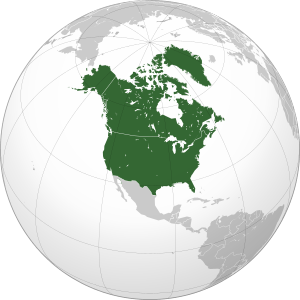Northern America facts for kids
 |
|
| Area | 21,780,142 km2 (8,409,360 sq mi) |
|---|---|
| Population | 364,295,996 (2018 est.) |
| Population density | 16.5/km2 (42.7/sq mi) |
| GDP (nominal) | $22.2 trillion (2018 est.) |
| Countries | |
| Dependencies | |
| Languages | English, French, Spanish, Danish, Greenlandic, and various recognized regional languages |
| Time zones | UTC (Danmarkshavn, Greenland) to UTC −10:00 (west Aleutians) |
| Largest cities |
(2005)
1.
2. 3. 4. 5. 6. 7. 8. 9. 10. |
| UN M49 code | 021 – Northern America003 – North America019 – Americas001 – World |
Northern America is the northernmost part of the larger continent of North America. Think of it as a specific section within North America. The exact borders of Northern America can be drawn in a few different ways.
One common way to define it is that it sits directly north of Middle America. Middle America includes places like Central America, Mexico, and the West Indies. This means Northern America's southern border is usually the border between Mexico and the United States.
The United Nations has its own way of dividing the world into regions. According to their plan, Northern America includes Bermuda, Canada, Greenland, Saint Pierre and Miquelon, and the United States. For the United States, this includes the main part of the country and Alaska, but not islands like Hawaii or Puerto Rico.
What is Northern America?
Maps showing the term Northern America have been around since 1755. Back then, this region was controlled by countries like France, Great Britain, and Spain.
Today, Northern America is mostly made up of Canada and the United States. These are both developed countries. This means they have strong economies and a high Human Development Index. People living there generally have good access to education, healthcare, and a good quality of life. Canada and the U.S. also work closely together in terms of their economies. They share many similar ways of life and social characteristics.
There's also a special way to define "Northern America" for studying plants. This is called the World Geographical Scheme for Recording Plant Distributions. In this system, Mexico is included, but Bermuda and Hawaii are not. Also, all of the Aleutian Islands, both Russian and American, are part of this plant-focused Northern America.
Countries and Territories
Northern America is home to two main countries and a few dependent territories. A dependent territory is a place that is governed by another country but is not fully independent.
Here's a quick look at the countries and territories in Northern America:
| Country / Dependency | Area (km²) |
Population (2018) |
Population density (per km²) |
Capital |
|---|---|---|---|---|
| 53.2 | 62,756 | 1,275 | Hamilton | |
| 9,984,670 | 37,064,562 | 3.4 | Ottawa | |
| 2,166,086 | 56,564 | 0.026 | Nuuk | |
| 242 | 5,849 | 25 | Saint Pierre | |
| 9,826,675 | 327,096,265 | 32.7 | Washington, D.C. |
How Many People Live Here?
The population of Northern America has grown a lot over the years. Most of the people in this region live in the United States. Canada's population makes up a smaller but growing part of the total.
Here's how the population has changed:
| Year | Population of Northern America |
%± | Canada population, % of Northern America |
U.S. population, % of Northern America |
||
|---|---|---|---|---|---|---|
| 1950 | 172,603,000 | — | 13,733,000 | 8.0% | 158,804,000 | 92.0% |
| 1960 | 204,649,000 | +18.6% | 17,847,000 | 8.7% | 186,721,000 | 91.2% |
| 1970 | 230,992,000 | +12.9% | 21,374,000 | 9.3% | 209,513,000 | 90.7% |
| 1980 | 254,007,000 | +10.0% | 24,417,000 | 9.6% | 229,476,000 | 90.3% |
| 1990 | 279,785,000 | +10.1% | 27,541,000 | 9.8% | 252,120,000 | 90.1% |
| 2000 | 312,427,000 | +11.7% | 30,588,000 | 9.8% | 281,711,000 | 90.2% |
| 2010 | 343,287,000 | +9.9% | 34,148,000 | 9.9% | 309,011,000 | 90.0% |
| 2020 | 368,870,000 | +7.5% | 37,742,000 | 10.2% | 331,003,000 | 89.7% |
See also
 In Spanish: América Norteña para niños
In Spanish: América Norteña para niños

